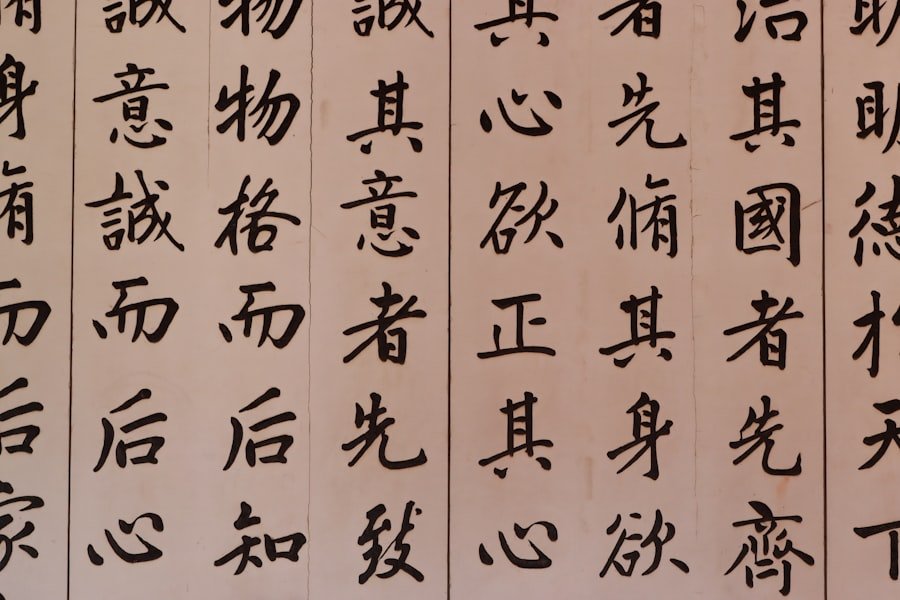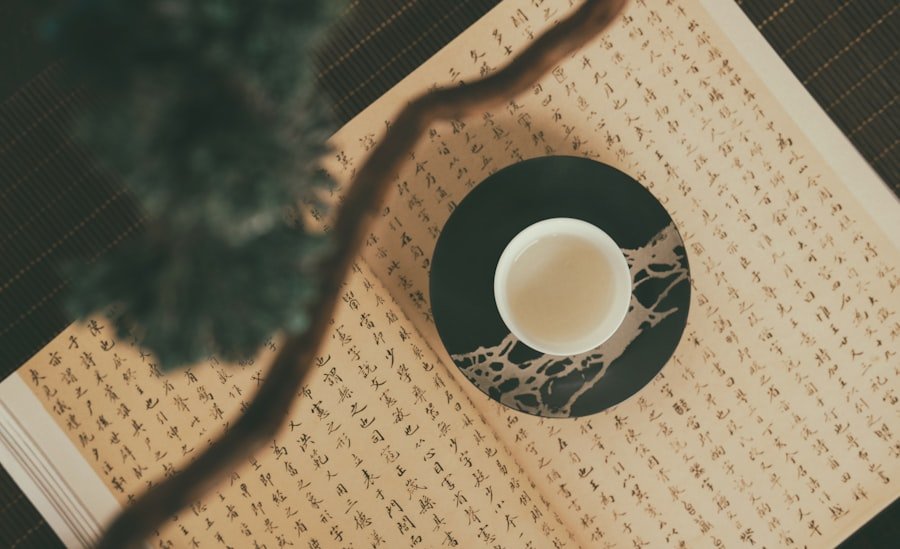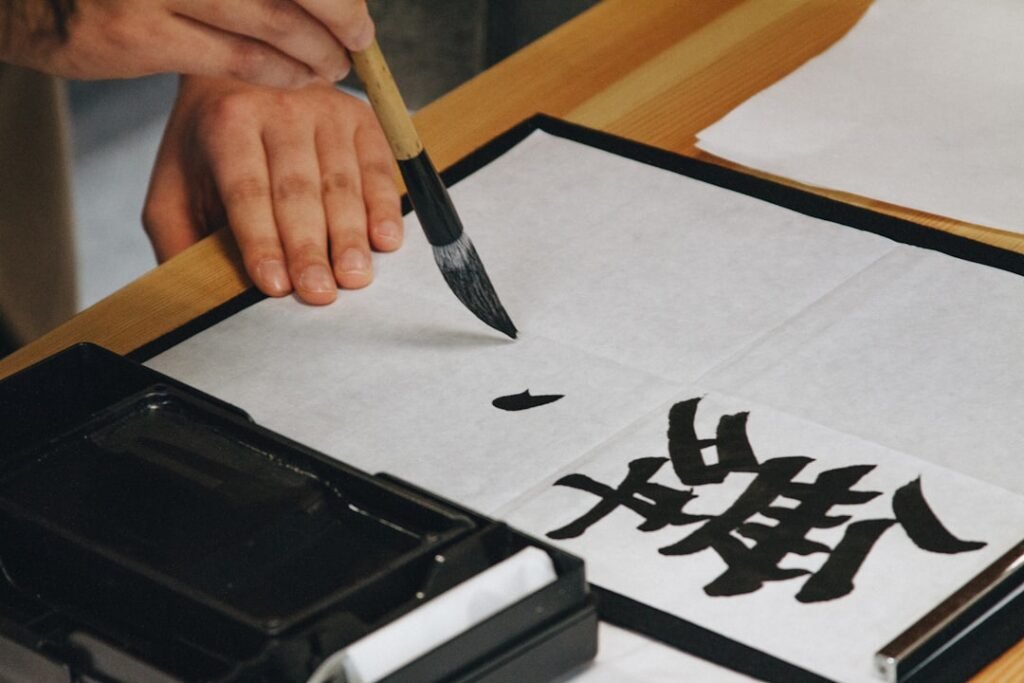Chinese calligraphy is a profound art form that has evolved over thousands of years, encompassing a variety of styles that reflect the cultural and historical contexts in which they were developed. Understanding these different styles is crucial for anyone wishing to delve into the world of calligraphy. Each style, from the elegant and flowing cursive script to the more rigid and structured regular script, offers unique insights into the philosophy and aesthetics of Chinese culture.
By familiarising oneself with these styles, practitioners can appreciate the nuances and subtleties that define each form, allowing for a deeper connection to the art. Moreover, recognising the distinct characteristics of each style can significantly enhance one’s own practice. For instance, the beauty of the running script lies in its fluidity and spontaneity, while the clerical script is celebrated for its clarity and precision.
By experimenting with various styles, calligraphers can discover their personal preferences and develop a unique voice within this ancient tradition. This exploration not only enriches their skills but also fosters a greater appreciation for the historical significance of each style, ultimately leading to a more fulfilling artistic journey. Master the art of Chinese calligraphy. Enroll now at the LC Chinese School in Oslo.
Table of Contents
ToggleSummary
- Understanding the different styles of Chinese calligraphy is crucial for appreciating its rich cultural heritage and artistic diversity.
- Proper posture and hand position are significant in Chinese calligraphy as they directly impact the quality and authenticity of the strokes and characters.
- Patience and practice are essential for mastering Chinese calligraphy, as it is a skill that requires dedication and continuous improvement.
- Chinese culture and history have a profound influence on calligraphy, shaping its techniques, aesthetics, and philosophical underpinnings.
- Traditional Chinese calligraphy tools and materials play a vital role in preserving the authenticity and tradition of this art form.
The Significance of Proper Posture and Hand Position
In the realm of Chinese calligraphy, proper posture and hand position are paramount to achieving both aesthetic beauty and technical proficiency. The way a calligrapher holds their brush and positions their body can greatly influence the fluidity and control of their strokes. A relaxed yet attentive posture allows for greater freedom of movement, enabling the artist to express themselves more fully through their work.
Conversely, poor posture can lead to tension and fatigue, hindering one’s ability to create graceful characters. Furthermore, hand position plays a critical role in the execution of strokes. The grip on the brush should be firm yet flexible, allowing for a delicate balance between control and spontaneity.
By mastering the correct hand position, calligraphers can achieve a range of effects, from bold and powerful strokes to soft and gentle lines. This attention to detail not only enhances the quality of the work but also cultivates a sense of mindfulness and presence in the practice, making each stroke a meditative experience.
The Need for Patience and Practice in Chinese Calligraphy

Chinese calligraphy is an art form that demands patience and dedication. Unlike many other artistic pursuits, mastering calligraphy is not an overnight endeavour; it requires consistent practice and a willingness to embrace imperfection. Each stroke must be executed with intention, and it is through repetition that one begins to internalise the techniques necessary for creating beautiful characters.
This process can be both challenging and rewarding, as it teaches practitioners the value of perseverance. Moreover, patience in calligraphy extends beyond mere technical skill; it also encompasses the emotional journey that accompanies artistic growth. As calligraphers progress in their practice, they may encounter moments of frustration or self-doubt.
However, it is through these challenges that they learn to cultivate resilience and self-compassion. Embracing the learning process allows artists to develop not only their skills but also a deeper understanding of themselves and their creative potential.
The Influence of Chinese Culture and History on Calligraphy
Chinese calligraphy is deeply intertwined with the rich tapestry of Chinese culture and history. It serves as a reflection of societal values, philosophical beliefs, and historical events that have shaped the nation over millennia. The evolution of calligraphy styles often mirrors significant cultural shifts, making it an invaluable lens through which to explore Chinese heritage.
For instance, during the Tang dynasty, calligraphy flourished as an esteemed art form, reflecting the era’s emphasis on scholarly pursuits and artistic expression. Additionally, calligraphy has played a vital role in preserving Chinese literature and philosophy. Many classical texts were transcribed by skilled calligraphers, ensuring that these works could be passed down through generations.
This connection between calligraphy and literature highlights the importance of written language in Chinese culture, as well as the reverence for those who dedicate themselves to mastering this art form. By studying calligraphy, practitioners not only engage with an artistic discipline but also connect with the broader narrative of Chinese history.
The Use of Traditional Chinese Calligraphy Tools and Materials
The tools and materials used in Chinese calligraphy are integral to the practice itself, each contributing to the overall experience and outcome of the artwork. Traditional calligraphy requires specific tools: brushes made from animal hair, ink sticks that are ground on an ink stone, rice paper or silk as surfaces for writing, and often a seal for marking finished pieces. Each tool has its own unique qualities that affect how ink flows and how strokes are formed.
Using these traditional materials fosters a deeper connection to the art form, as practitioners engage with centuries-old techniques that have been passed down through generations. The tactile experience of grinding ink or selecting the right brush can be meditative in itself, allowing artists to immerse themselves fully in their practice. Furthermore, understanding how different materials interact with one another can lead to exciting discoveries in technique and style, encouraging experimentation and personal expression.
The Role of Stroke Order and Direction in Chinese Calligraphy

In Chinese calligraphy, stroke order and direction are fundamental principles that govern how characters are formed. Each character is composed of a series of strokes that must be executed in a specific sequence to maintain balance and harmony within the composition. Mastering stroke order not only ensures that characters are legible but also enhances their aesthetic appeal.
A well-executed stroke conveys a sense of rhythm and flow that is essential to the overall beauty of the piece. Moreover, understanding stroke direction is crucial for achieving the desired effects in calligraphy. Different strokes can convey varying emotions or meanings depending on how they are executed.
For instance, upward strokes may evoke feelings of hope or aspiration, while downward strokes can suggest stability or grounding. By paying attention to these nuances, calligraphers can imbue their work with deeper significance, transforming simple characters into powerful expressions of thought and feeling.
The Impact of Calligraphy on Mental and Emotional Well-being
Engaging in Chinese calligraphy offers numerous mental and emotional benefits that extend beyond mere artistic expression. The practice encourages mindfulness by requiring focus and concentration on each stroke, allowing individuals to enter a state of flow where worries and distractions fade away. This meditative quality can serve as a form of stress relief, providing a sanctuary for those seeking respite from the demands of daily life.
Additionally, calligraphy fosters a sense of accomplishment as practitioners witness their progress over time. Each completed piece serves as a tangible representation of their dedication and growth, instilling confidence and pride in their abilities. This positive reinforcement can have a profound impact on one’s self-esteem and overall mental health, making calligraphy not just an art form but also a valuable tool for personal development.
The Value of Seeking Guidance and Feedback from Experienced Calligraphers
As with any art form, seeking guidance from experienced practitioners can significantly enhance one’s learning journey in Chinese calligraphy. Mentorship provides invaluable insights into techniques, styles, and philosophies that may not be readily accessible through self-study alone. Experienced calligraphers can offer constructive feedback on one’s work, helping to identify areas for improvement while also celebrating successes.
Moreover, engaging with a community of fellow calligraphers fosters a sense of belonging and support. Sharing experiences, challenges, and triumphs creates an environment where individuals can learn from one another while cultivating friendships based on a shared passion for this ancient art form. This collaborative spirit not only enriches one’s practice but also reinforces the idea that calligraphy is not merely an individual pursuit but a collective celebration of culture and creativity.
The Challenges of Learning Chinese Calligraphy as a Non-Native Speaker
For non-native speakers embarking on the journey of learning Chinese calligraphy, there are unique challenges that may arise along the way. One significant hurdle is grappling with the intricacies of Chinese characters themselves; their complexity can be daunting for those unfamiliar with the language. Additionally, understanding cultural references embedded within characters may require extra effort to fully appreciate their significance.
However, these challenges should not deter aspiring calligraphers from pursuing their passion. With determination and practice, non-native speakers can develop their skills while simultaneously deepening their understanding of Chinese culture and language. Many resources are available to support learners on this journey, including classes specifically designed for non-native speakers that focus on both technique and cultural context.
The Opportunities for Creativity and Personal Expression in Chinese Calligraphy
Chinese calligraphy is not merely about replicating characters; it is an opportunity for creativity and personal expression. While traditional techniques provide a foundation for practice, artists are encouraged to explore their unique styles and interpretations within this framework. This freedom allows practitioners to infuse their work with individuality while still honouring the rich heritage of calligraphy.
Furthermore, experimenting with different materials or incorporating elements from other art forms can lead to exciting innovations within one’s practice. Whether through colour choices or mixed media approaches, calligraphers have endless possibilities for self-expression that can result in truly original works of art. This creative exploration not only enhances technical skills but also nurtures a deeper connection to one’s artistic voice.
The Potential for Chinese Calligraphy to Connect People Across Cultures and Languages
Chinese calligraphy possesses a remarkable ability to transcend cultural boundaries and connect people from diverse backgrounds. As an art form rooted in centuries-old traditions, it serves as a bridge between cultures by inviting individuals to engage with its beauty regardless of linguistic proficiency. Through shared appreciation for this intricate craft, people can foster mutual respect and understanding.
Moreover, participating in calligraphy classes or workshops provides opportunities for cross-cultural exchange where individuals can learn from one another’s perspectives while honing their skills together. In Oslo, for instance, LC Chinese School offers specialised courses in Chinese calligraphy that cater to both beginners and advanced practitioners alike. These classes not only teach technical skills but also encourage participants to explore the cultural significance behind each stroke they make.
At LC Chinese School in Oslo, students are immersed in an environment that celebrates both tradition and innovation within Chinese calligraphy. With experienced instructors guiding them through various styles and techniques, learners have the chance to develop their skills while connecting with others who share their passion for this timeless art form. Whether one seeks personal enrichment or aims to deepen their understanding of Chinese culture through calligraphy, LC Chinese School provides an invaluable platform for growth and exploration.
In conclusion, Chinese calligraphy is an intricate art form that encompasses various elements such as style understanding, posture significance, patience cultivation, cultural influence, tool usage, stroke mastery, mental well-being impact, mentorship value, learning challenges for non-native speakers, creative opportunities, and cross-cultural connections. Engaging with this ancient practice offers individuals not only technical skills but also profound insights into themselves and the world around them—making it an enriching pursuit for anyone willing to embark on this artistic journey.
Master the art of Chinese calligraphy. Enroll now at the LC Chinese School in Oslo.







